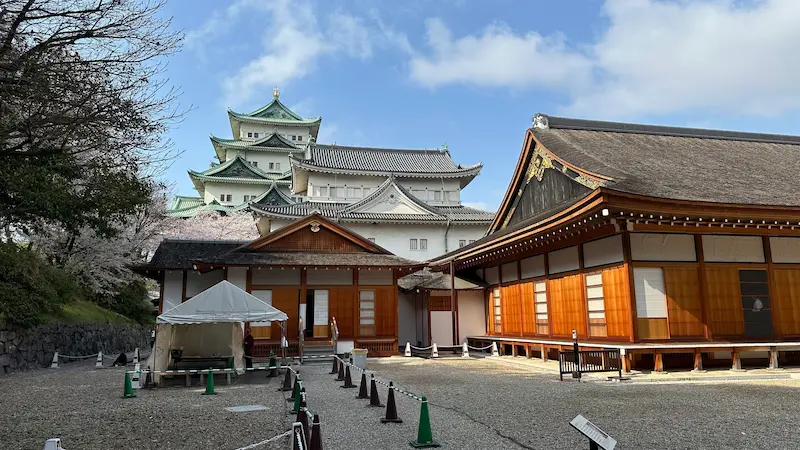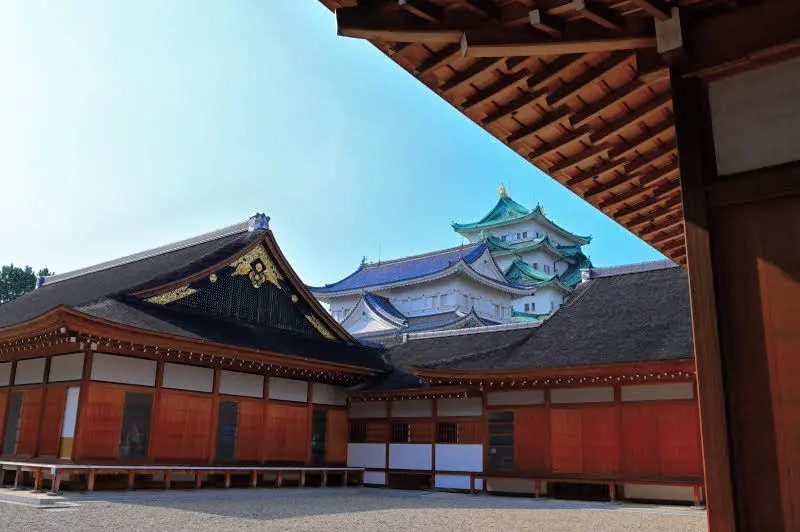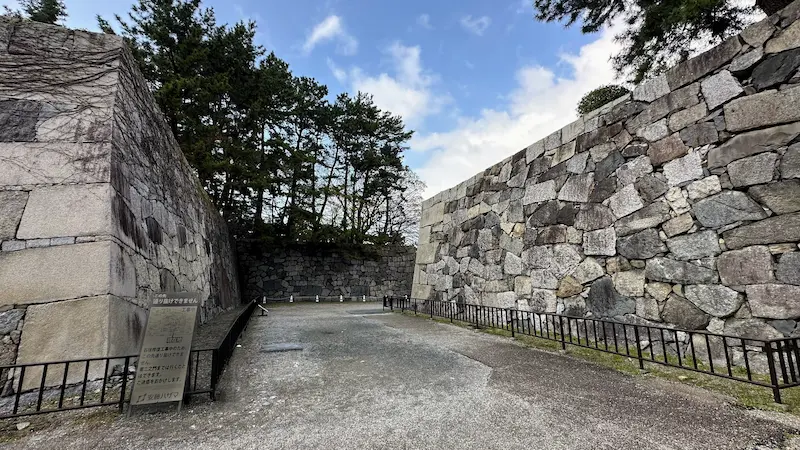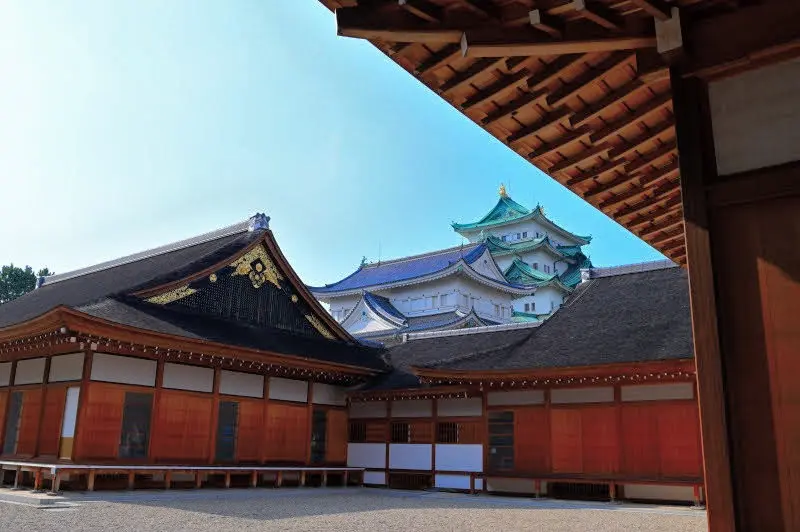Explore the Refined Beauty Designed for the Shogun: A Journey Through the Honmaru Palace of Nagoya Castle
Within the Honmaru (Main Compound) of Nagoya Castle lies a collection of historically rich and architecturally stunning sites, including the Honmaru Palace, originally built as the official residence and government office of Tokugawa Yoshinao. Highlights include the Yudono Shoin (Bathhouse Study), the Kuroki Shoin, said to be connected to Kiyosu Castle, and the enormous Kiyomasa Stone. In this article, we’ll walk you through these faithfully restored cultural treasures, offering insights into their significance and must-see features.
Yudono Shoin & Kuroki Shoin

🏛 Overview
The Yudono Shoin (Bathhouse Study) and Kuroki Shoin (Dark-Wood Study) within Honmaru Palace were exclusively reserved for the shogun. The Yudono Shoin served as a private bathing and resting facility, complete with a bathhouse. The Kuroki Shoin, meanwhile, is believed to have been relocated from Kiyosu Castle, where it once served as Tokugawa Ieyasu’s lodgings. Unlike the rest of the palace—constructed primarily with cypress—the Kuroki Shoin features high-quality pine wood, giving it a darker hue that inspired its name.
Though both buildings were destroyed in the air raids of 1945, they were meticulously reconstructed based on detailed historical documents and reopened to the public in 2018.
🗺 Address
1-1 Honmaru, Naka-ku, Nagoya, Aichi Prefecture – Inside Honmaru Palace
🚶 Access
Approx. 1-minute walk (50 meters) from the Seinan Corner Turret.
⏳ Suggested Visiting Time
- Quick visit: Approx. 5 minutes (exterior only)
- Full experience: Approx. 30 minutes (interior tour)
📍 Highlights
- Yudono Shoin Bathhouse: A glimpse into the bathing facilities used exclusively by the shogun.
- Kuroki Shoin Fusuma Paintings: Elegant monochrome ink paintings (suibokuga) create a calming ambiance.
- Seasonal Tip: Enjoy cherry blossoms in spring as a beautiful backdrop to these historic structures.
📌 Trivia
- Unexpected History: The Kuroki Shoin is believed to be a relocated building from Kiyosu Castle, once used by Tokugawa Ieyasu himself.
- Hidden Gem: Some of the fusuma paintings from the Kuroki Shoin survived the war and are occasionally displayed during special exhibitions.
- Famous Connection: The Honmaru Palace was originally constructed by Tokugawa Ieyasu for his ninth son, Yoshinao, making it one of the most prestigious residential structures of the Tokugawa clan.
Honmaru Palace

🏛 Overview
The Honmaru Palace of Nagoya Castle was completed in 1615 as both the residence and government office of Tokugawa Yoshinao, the first lord of the Owari Domain. Later, it was also used as the official accommodation for visiting shoguns. Lavishly adorned with Kano school paintings and intricate gold fittings, the palace was hailed as the masterpiece of early modern castle residences.
It was designated as Japan’s first National Treasure in 1930, but tragically destroyed in World War II bombings in 1945. Thanks to surviving blueprints and photographs, an ambitious reconstruction began in 2009, culminating in a faithful restoration completed in 2018.
🗺 Address
1-1 Honmaru, Naka-ku, Nagoya, Aichi Prefecture – Inside Nagoya Castle
🚶 Access
Approx. 5-minute walk (200 meters) from Yudono & Kuroki Shoin.
⏳ Suggested Visiting Time
- Quick visit: Approx. 10 minutes (exterior)
- Full interior tour: Approx. 1 hour
📍 Highlights
- Grand Entrance: A stately entry used only by the shogun.
- Omote Shoin (Formal Reception Hall): Features spectacular gold-leaf wall paintings.
- Taimeisho (Audience Room): Lavishly decorated for family receptions and banquets.
- Jorakuden (Shogun’s Quarters): The most luxurious room, built specifically for shogunal visits, featuring breathtaking Kano school murals.
- Seasonal Tip: Capture the palace’s grandeur amidst cherry blossoms or autumn foliage.
📌 Trivia
- Historical Significance: Considered the pinnacle of early modern Japanese architecture, the palace exemplified Edo-period luxury and design.
- Faithful Reconstruction: The faithful reconstruction was based on original blueprints, photographs, and measurement data.
- Famous Connection: Originally built for Tokugawa Yoshinao, it later became the official lodging for shoguns visiting Nagoya.
Honmaru East Ichinomon Gate Ruins

🏛 Overview
The Honmaru East Ichinomon Gate was once a key eastern entrance to the Honmaru compound. Along with the Higashi Ninomon (East Second Gate), it formed a defensive masugata (box-shaped gate complex). The gate was destroyed in the 1945 air raids, and today only its stone foundations remain.
🗺 Address
1-1 Honmaru, Naka-ku, Nagoya, Aichi Prefecture – Inside Nagoya Castle
🚶 Access
Approx. 2-minute walk (60 meters) from Honmaru Palace.
⏳ Suggested Visiting Time
- Quick visit: Approx. 5 minutes
- In-depth exploration: Approx. 15 minutes
📍 Highlights
- Stone Foundations: Observe the original masugata-style base and its strategic layout.
- Scenic Surroundings: Enjoy a tranquil walk through the historical heart of the castle.
- Seasonal Tip: During cherry blossom season, the stone structures contrast beautifully with the floral scenery.
📌 Trivia
- Key Role: This gate, in tandem with the East Second Gate, played a critical role in castle defense.
- A Favorite Among History Buffs: Though not widely advertised, the ruins are a favorite among history buffs.
- Famous Connection: Built under the orders of Tokugawa Ieyasu, like the rest of Nagoya Castle.
Kiyomasa Stone

🏛 Overview
Located near the East Second Gate, the Kiyomasa Stone is the largest stone used in Nagoya Castle’s stone walls—roughly the size of eight tatami mats and estimated to weigh over 10 tons. It is said to have been transported by the legendary castle-builder Kato Kiyomasa, hence its name.
However, records indicate the stone was likely placed by Kuroda Nagamasa, not Kiyomasa himself.
The castle’s stonework was divided among 20 feudal lords from western Japan, each marking their assigned stones with a unique emblem. Kiyomasa oversaw the construction of the tenshudai (main tower base) and is said to have led 20,000 workers from Kumamoto, completing the job in just three months.
🗺 Address
1-1 Honmaru, Naka-ku, Nagoya, Aichi Prefecture – Near Honmaru East Second Gate
🚶 Access
Approx. 1-minute walk (5 meters) from the East First Gate Ruins.
⏳ Suggested Visiting Time
- Quick visit: Approx. 5 minutes
- Full appreciation: Approx. 15 minutes
📍 Highlights
- Kiyomasa Stone’s Sheer Scale: The largest block in the entire castle, its presence is unforgettable.
- Inscribed Marks: Discover carvings left by the daimyo tasked with stone delivery.
- Seasonal Tip: Cherry blossoms enhance the grandeur of this massive stone.
📌 Trivia
- Unexpected History: Although named after Kiyomasa, the actual construction was led by Kuroda Nagamasa.
- Impressive Scale: Nagoya Castle’s stone walls span a total length of 8.2 km—an architectural feat of the Edo period.
- Famous Connection: Kato Kiyomasa, renowned for his castle expertise, led the building of the tenshudai foundation.




comment